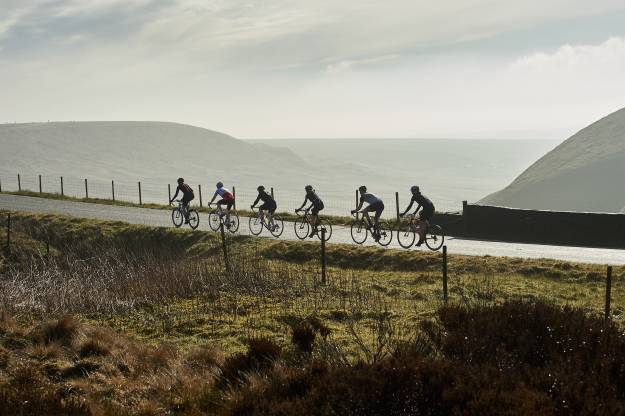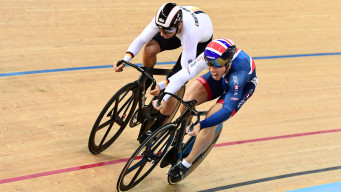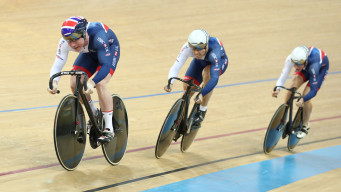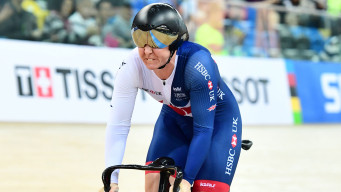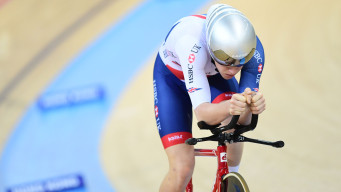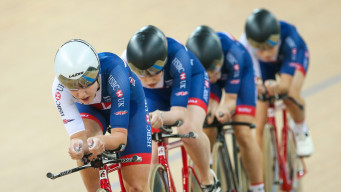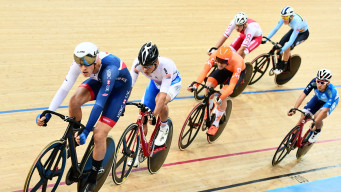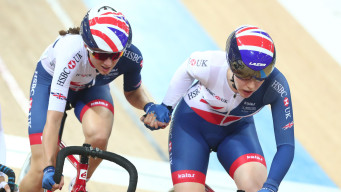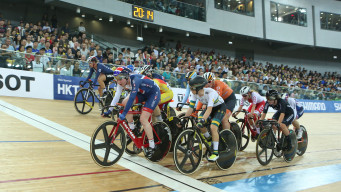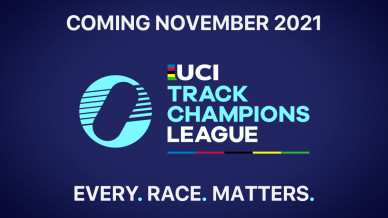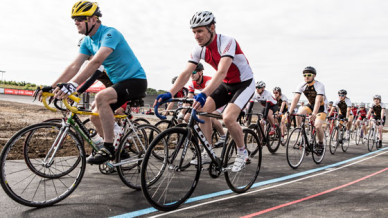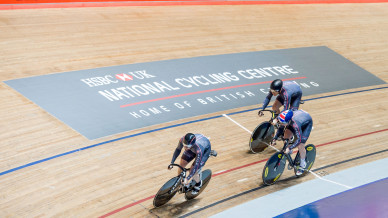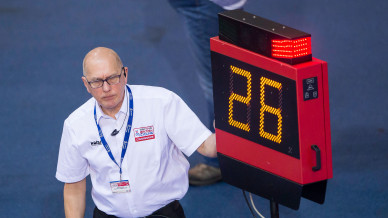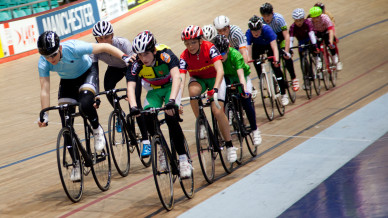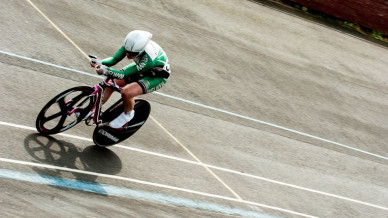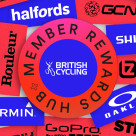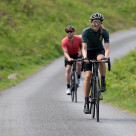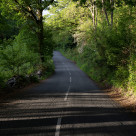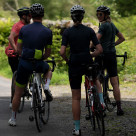How to get into track cycling
Introduction to track cycling
Track cycling is all about speed, stamina, technique, tactics and nerve. British Cycling supports newcomers to track cycling, helping riders to progress from the induction through an accreditation system.
Track cycling has brought more glory to Britain than any other event in recent Olympic history.
Sir Chris Hoy, Dame Sarah Storey, Laura Trott and Jason Kenny are just some of the athletes that have helped to create an aura of invincibility around the British team in recent years.
Following track cycling has never been easier as Britain regularly plays host to both domestic and international events, including the Revolution Series, masters events and European and world championships.
Fans can get within touching distance of their favourite riders and, even when the track is quiet, there is always something to watch as the riders and coaches populate the track centre during the meetings.
The UK has a lot to offer those considering taking up track cycling, with taster sessions available at world class indoor velodromes, such as the National Cycling Centre in Manchester which houses the British team.
There are also outdoor tracks which offer a different track cycling experience; the Herne Hill velodrome is less steeply banked than the Olympic standard tracks and would therefore be an ideal place to learn the techniques of the sport.
British Cycling support newcomers to track cycling, helping riders to progress from the induction through an accreditation system.
On passing this riders will be qualified to take part in more advanced structured training sessions and to race.
Becoming a member means that you are fully supported to race, ride or follow track cycling.


The venue
The National Cycling Centre in Manchester is home to the British track team and plays host to a great deal of their training.
The Lee Valley Velopark was built for London 2012 and still hosts high profile international track meets. The Sir Chris Hoy Velodrome in Glasgow and the Wales National Velodrome in Newport are the bases of Scottish and Welsh Cycling respectively whilst the newly constructed Derby Velodrome has already played host to the Revolution Series. Calshot Velodrome in Southampton is the smallest indoor velodrome in the United Kingdom at just 142m long.
Track cycling takes place on indoor and outdoor oval tracks ranging from less than 200 to over 400 metres in length, with surfaces made from a variety of materials including wood, tarmac and concrete. Tracks are banked to varying degrees to enable riders to maintain high speeds.
Olympic standard venues are indoor 250 metre wooden tracks with coloured bands painted at various intervals up the track.
The lowest black line defines the length of the track, 90cm above that is the red sprinter's line; the gap between black and red marks the optimum route around the track.
At a minimum of 250cm, or halfway up the track, there is a blue line called the stayer's line, used in stayer races (races behind pacemaker-motorbikes) as a separation line.
The track rider

Track cycling is suitable for a wide range of riders.
Sprint athletes tend to be muscular and capable of producing massive power for short distances while endurance riders are lighter and more suited to maintaining high speeds over longer distances.
Track cycling events
The bikes
Standard track bike
Track bikes are among the simplest types of bike available, with no brakes and a single ‘fixed’ gear, meaning that riders cannot ‘freewheel’. Though simple, the bikes are often technically advanced with the best made from carbon fibre, resulting in light weight yet great strength, stiffness and efficiency.
The top riders can reach speeds of up to 60kpm so the absence of brakes is vital to prevent accidents, as riders are able to ride close together at high speeds without the worry of someone ahead suddenly slamming their brakes on.
One chainring and one sprocket means one gear. Choosing what sized gear to ride is dependent on the event, the strengths and weaknesses of the rider and their tactics. A bigger gear will take you further for each pedal turn but will be slower to accelerate and harder to spin with tired legs. Choosing the right or wrong sized gear to ride can often determine winning or losing a track race.
As rotating spokes create turbulence and drag, a spoke-less disc wheel will always be faster once up to rolling speed. However a disc wheel can be heavier and slower to accelerate so, in events that require changes of pace, riders may use a disc on the rear only.
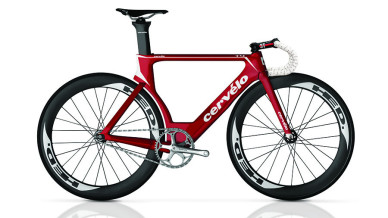
Pursuit configuration
In races against the clock, you’ll see riders using tri-bars with elbow pads and extensions, that allow them to adopt a stretched out aerodynamic tuck.
The only time you’ll see multiple riders on the track at the same time using tri-bars is during the team pursuit.
In the sprint time trials some racers will use drops and some will use tri-bars. Although the tri-bars offer aerodynamic advantages, some sprinters feel this is offset by the power lost in an aero position and by the time lost settling down onto the tri-bars after their starting effort.
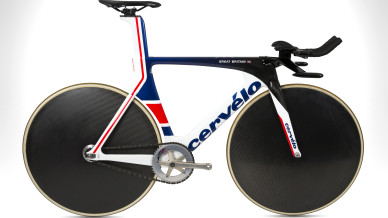
The kit and clothing
Skin suit
If you are new to track cycling, do not panic! No one is going to expect you to turn up in a skin suit on your taster session!
The general advice is to wear two layers of well-fitting sports clothing so that, in the case that you take a tumble, your skin will be best protected.
The pro-riders wear the skin suits for maximum aerodynamic gains and when sprints are won by hundredths of a second, every little helps!
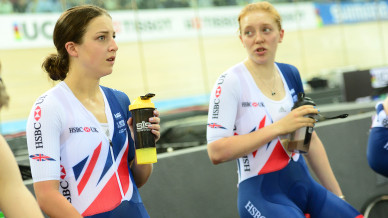
Helmet - Endurance events
For endurance events against the clock, such as the individual pursuit and team pursuit, a more aerodynamic helmet is used.
Against the clock a time trial helmet can represent one of the best aero gains.
However, it has to be right for the riding position. If a rider keeps their head up and still, a long tailed helmet can work well but, if they tend to dip or move their head, a stub tailed helmet could be the better option.
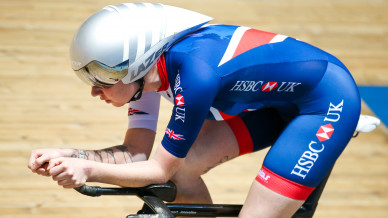
Lazer Wasp air
The Wasp Air is a shorter version of the Wasp helmet designed to meet the needs of track riders.
The WASP Air is all about Watt Saving Performance, derived from the original WASP which benefitted from extensive wind tunnel testing and athlete feedback
The reduction in pressure drag causes the helmet to travel at the same speed for less energy input.
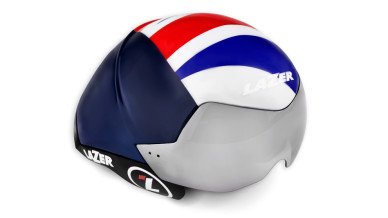
Get involved with track cycling
London to host two rounds of inaugural UCI Track Champions League
British Cycling is delighted to today announce that London’s Lee Valley VeloPark will host two rounds of the inaugural UCI Track Champions League on 3 - 4 December 2021.
Track cycling clubs
Many of the UK’s cycling clubs offer track cycling sessions as one of their training and competitive options.Check out British Cycling’s Find a club page to see what’s going on in your area.
Track cycling events
The track racing season extends throughout the year, with summer and winter track leagues at a number of venues around the country.
There is racing for all age groups and a range of abilities.
Volunteer
Support the sport by volunteering your time and skills at your local track event.
There are opportunities for a variety of roles including timekeepers, judges and scrutineers.
British Cycling has a range of volunteer education courses to support your development.
Track cycling technique & training
You can learn to ride the track at a number of venues around the country, with taster sessions for complete beginners through to more structured, event specific training for more experienced riders.
Race licence
If you are planning on taking part in a competitive bike race, there is a good chance that you will need to add on a full race licence while purchasing your membership, particularly if you are going to be doing road or track racing.
You will also need a full race licence to earn points in any national or regional rankings.

